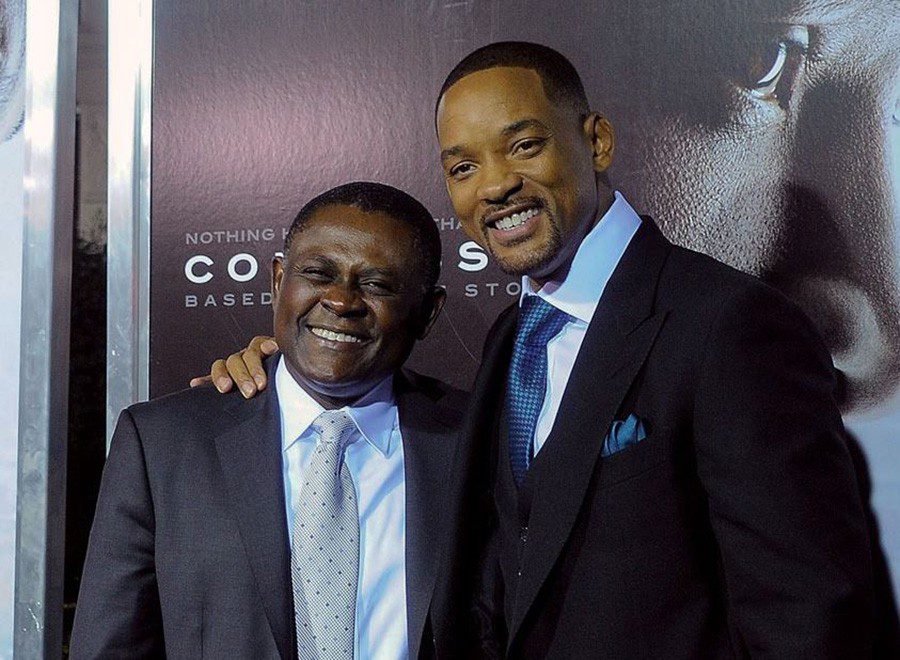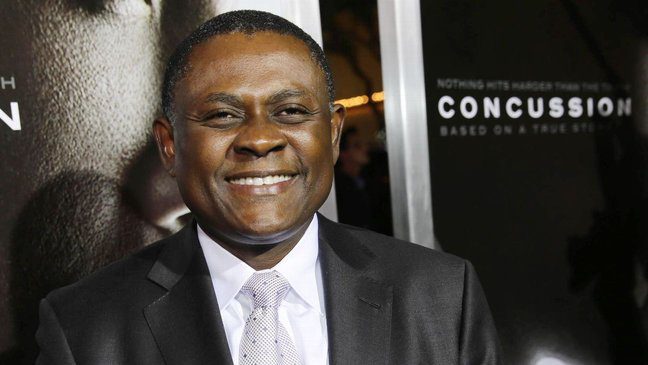Bennet Ifeakandu Omalu is a Nigerian physician, forensic pathologist and neuropathologist who was the first to discover and publish findings on chronic traumatic encephalopathy (CTE) in American football players while working at the Allegheny County coroner’s office in Pittsburgh.
Dr. Omalu had most of his earlier formative education in Nigeria. He became disillusioned with Nigeria after presidential candidate Moshood Abiola failed to win the Nigerian presidency during an inconclusive election in 1993 and began to search for scholarship opportunities in the United States. Omalu first came to Seattle, Washington in 1994 to complete an epidemiology fellowship at the University of Washington. In 1995, he left Seattle for New York City, where he joined Columbia University’s Harlem Hospital Center for a residency training program in anatomic and clinical pathology
The Movie Concussion which starred Will Smith as Dr. Bennet Omalu was nominated for the Golden Globe Awards in the Best Actor Drama category.
In her book, the leadership gap, Lolly Daskal shares the story of Dr. Bennet Omalu as a truth-teller, which is one of the leadership styles she expounded on in her book. The truth-teller embraces candor and needs the courage to speak the truth against the system (NFL) as Dr. Omalu did, Lolly wrote in the Leadership Gap about Dr. Omalu:
On September 24, 2002, Mike Webster—a former center for the Pittsburgh Steelers and the Kansas City Chiefs football teams, whose professional career spanned seventeen years—died at the relatively young age of fifty. Considered by many to be the best center in football history, Mike was a four-time Super Bowl champion, a nine-time Pro Bowl participant, a seven-time All-Pro, and a member of the NFL Pro Football Hall of Fame. He also endured an estimated 25,000 violent collisions with other players during the long course of his career. It was determined that—at the time of his death—Mike Webster had suffered from a variety of physical and mental ailments, including bone and muscle pain, amnesia, dementia, and depression.

He was addicted to prescription painkillers and Ritalin, out of money, homeless, and divorced. He lived for some time in a pickup truck before he died3—surviving on Pringles potato chips and Little Debbie pecan rolls. Immediately after Mike Webster died, his body was taken to the Allegheny County Coroner’s Office in Pittsburgh for a routine autopsy to determine the cause of death. There, forensic pathologist Bennet Omalu was assigned to perform the autopsy. Dr. Omalu—born in 1968—immigrated to the United States from Nigeria in 1994 to complete a fellowship in epidemiology at the University of Washington in Seattle.
According to a report in the Washington Post, “Watching coverage of Webster’s death (the cause was not released), Omalu was shocked that the people who talked about him on television mocked his intelligence. Omalu wondered if perhaps Webster suffered from dementia pugilistica, or punch-drunk syndrome”—an affliction often suffered by boxers, whose sport inevitably exposes them to repeated blows to the head. The condition causes memory loss, dementia, dizzy spells, speech problems, tremors, explosive behavior, and more.
However, when Dr. Omalu removed Mike Webster’s brain for examination, he was surprised to find that—at least on the surface—it appeared to be completely normal, without the contusions that would be evident in the case of dementia pugilistica. This puzzled Omalu—a neuropathologist by training—who was convinced that there must be some sort of mechanism at work that caused the football great’s severe mental decline. So he decided to take a closer look at the football player’s brain.
At his own expense, Omalu had special brain tissue slides prepared, and he viewed them through a microscope. What he saw through the microscope’s lens surprised him: the telltale red flecks of abnormal tau protein that are the result of repeated blows to the brain. Omalu recalls, “I had to make sure the slides were Mike Webster’s slides. I looked again. I saw changes that shouldn’t be in a fifty-year-old man’s brain, and also changes that shouldn’t be in a brain that looked normal.
Concerned about the potential implications for the health of other professional football players, in July 2005, Omalu published a paper about his findings in the medical journal Neurosurgery. In this article, Omalu dubbed the condition he discovered chronic traumatic encephalopathy, or CTE. He was convinced that the NFL would receive his findings with open arms and use them to “fix the problem.” But Dr. Bennet Omalu was wrong.
Instead, the NFL began a vigorous campaign to cover up the findings—refuting any connection between football and CTE, and doing everything in its power to discredit Dr. Omalu. Soon after Omalu’s paper was published, three doctors on the NFL payroll—Ira Casson, Elliot Pellman, and David Viano—demanded that Neurosurgery retract Omalu’s paper. In their letter to the editor, the NFL-paid doctors said, “These statements are based on a complete misunderstanding of the relevant medical literature. . . . Omalu et al.’s description of chronic traumatic encephalopathy is completely wrong.”7 The journal declined to retract the paper.
In the meantime, Dr. Omalu was assigned another autopsy of a high-profile football player—this time former Pittsburgh Steelers guard Terry Long, who committed suicide at the age of forty five after a long history of symptoms almost identical to those of Mike Webster. He, too, suffered from memory loss, depression, and psychotic behavior—and he was bankrupt and living alone. When Dr. Omalu examined samples of Terry Long’s brain, he found the same telltale red flecks of abnormal tau proteins. It was CTE. Dr. Omalu published another paper in Neurosurgery—this one based on his findings in the Terry Long case.
By this time, the issue of CTE and professional football players was gaining attention in the press, and Dr. Omalu was at the center of the storm. When reporters asked the NFL about Dr. Omalu’s findings, the responses were swift—and negative. “Preposterous.” “It’s not appropriate science.” “Purely speculative.” A friend warned Dr. Omalu that by speaking the truth about his discoveries, he was putting himself in danger. “You are challenging one of the most powerful organizations in the world, Omalu was told. “There may be other things going on that you’re not aware of. Be careful!”8 Dr. Omalu’s own father called him from Nigeria, fearful of what could happen to his son. “Stop doing this work, Bennet. I have heard not nice things about the NFL; they are very powerful, and some of them not nice!
Yet Dr. Bennet Omalu continued in his quest to tell the truth—regardless of the pressure for him to stop. He examined the brains of two other high-profile football players—former Philadelphia Eagles safety Andre Waters and former Pittsburgh Steelers lineman Justin Strzelczyk. The results were the same: CTE.
In 2007, as pressure in the media continued to grow, NFL commissioner Roger Goodell convened a concussion summit. Invited to the meeting were doctors and trainers from every football team, along with a group of scientists. Notably absent from that group of scientists was Dr. Bennet Omalu, who had by then become public enemy number one in the eyes of the NFL. Neurosurgeon Julian Bailes—a colleague of Omalu’s—commented on the situation, They were trying to blackball him, lock him out, marginalize him. He was the whistleblower.
According to Peter Landesman, director of the film Concussion, which told the story of Dr. Omalu’s quest to bring the truth about CTE to the public’s attention, the NFL and its allies threatened Omalu and his family in a variety of ways—trying to silence him. “Bennet was followed,” says Landesman. “He was pursued very often. He would come down to his parking lot and find all four tires of his car punctured a number of times, happened a number of times. They were terrified they’d be deported. He was essentially chased and hounded out of Pittsburgh.
Ultimately, Dr. Omalu was forced to resign his position with the Allegheny County Coroner’s Office and find employment elsewhere. He eventually accepted a job as chief medical examiner for San Joaquin County in the rural Central Valley of California. Dr. Omalu’s career was ruined, his professional reputation tarnished, and his personal life torn apart—all by an NFL organization that was more concerned about its bottom line than it was about the veteran football players whose lives had been destroyed by CTE.
I was naive. There are times I wish I never looked at Mike Webster’s brain. It has dragged me into worldly affairs I do not want to be associated with. Human meanness, wickedness, and selfishness. People trying to cover up, to control how information is released. I started this not knowing I was walking into a minefield.
Yet Dr. Omalu continued to speak the truth. He felt he owed his candor to the professional football players who were afflicted with this terrible disease, and their wives and families.
In 2013, the NFL reached a $765 million settlement with the more than four thousand former football players who joined in a class-action lawsuit against the league for concealing the dangers of concussions and too quickly putting injured players back into play. The settlement was approved by a federal judge in 2015. In agreeing to the settlement, the NFL admitted no wrongdoing in the concussion saga. According to NFL executive vice president Jeffrey Pash, “We thought it was critical to get more help to players and families who deserve it than spend many years and millions of dollars on litigation.”
What the NFL’s statement doesn’t mention is that if it wasn’t for the efforts of Dr. Bennet Omalu—the man whose complete surname, Onyemalukwube, in his native language means “If you know, come forth and speak”—there would have been no settlement, and the CTE epidemic among professional football players might never have come to light. Omalu says, “Before CTE, retired football players were ridiculed and dismissed. I think they’re beginning to get the attention they need.
Onyemalukwube, in his native language means “If you know, come forth and speak“
Dr. Bennet Omalu’s effort to tell the truth to a very powerful organization like the NFL required courage and chutzpah. His effort led to the NFL re-examine the way they treated their players.
If you speak don’t fear, if you fear don’t speak. Thank you Dr. Omalu for your candor and for flying the flag of the continent high.
All the best in your quest to get better. Don’t Settle: Live with Passion.



Comments are closed.